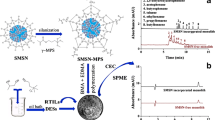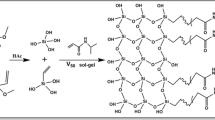Abstract
A novel molecularly imprinted xerogel (MIX) based on organically modified silica (ORMOSIL) was successfully prepared for on-line capillary microextraction (CME) coupled with high-performance liquid chromatography (HPLC). The sol–gel-based xerogel was prepared using only one precursor and exhibited extensive selectivity towards triazines along with significant thermal and chemical stability. Atrazine was selected as a model template molecule and 3-(trimethoxysilyl)propylmethacrylate (TMSPMA) as a precursor in which the propylmethacrylate moiety was responsible for van der Waals, dipole–dipole, and hydrogen-bond interactions with the template. This moiety plays a key role in creation of selective sites while methoxysilyl groups in TMSPMA acted as crosslinkers between the template and the propylmethacrylate moiety. Moreover, a non-imprinted xerogel (NIX) was also prepared in the absence of the template for evaluating the extraction efficiency of the prepared MIX. Then, the prepared imprinted and non-imprinted xerogels were used for extraction of three selected analytes of triazines class including atrazine, ametryn, and terbutryn, which have rather similar structures. The extraction efficiency of the prepared xerogel for atrazine, the template molecule, was found to be ten times greater than the efficiency achieved by the non-imprinted one. In the meantime, the extraction efficiency ratio of MIX to NIX for ametryn and terbutryn was also rather significant (eight times). Moreover, other compounds from different classes including dicamba, mecoprop, and estriol were also analyzed to evaluate the selectivity of the prepared MIX towards triazines. The ratio of enrichment factors (EF) of MIX to NIX for atrazine, ametryn, terbutryn, dicamba, mecoprop, and estriol were about 10, 8, 8, 2, 2, and 3, respectively. The linearity for the analytes was in the range of 5–700 μg L−1. Limit of detection was in the range of 1–5 μg L−1 and the RSD% values (n = 5) were all below 6.6 % at the 20 μg L−1 level. The developed method was also applied to real water samples and the relative recovery percentages obtained for the spiked water samples were from 92 to 104 %. The CME loop, containing the prepared MIX, exhibited a rather long life time due to its remarkable solvent and mechanical stability. Even after 100 runs, no decrease in the peak areas was observed. The developed method could easily provide the possibility of preparing a selective sorbent in a unique way with the lowest possible cost and time.




Similar content being viewed by others
References
Arthur CL, Pawliszyn J (1990) Anal Chem 62:2145–2148
Zhang X, Oakes KD, Luong D, Metcalfe CD, Pawliszyn J, Servos MR (2011) Anal Chem 83:2371–2377
Segro SS, Triplett J, Malik A (2010) Anal Chem 82:4107–4113
Chong SL, Wang D, Hayes JD, Wilhite BW, Malik A (1997) Anal Chem 69:3889–3898
Bagheri H, Piri-Moghadam H, Es'haghi A (2011) J Chromatogr A 1218:3952–3957
Ansell R, Krij D, Mosbach K (1996) Curr Opin Biotechnol 7:89–94
Haupt K (2003) Chem Commun 2:171–178
Gupta R, Kumar A (2008) Biotechnol Adv 26:533–547
Lordel S, Hugon FC, Eudes V, Pichon V (2010) J Chromatogr A 1217:6674–6680
Xu Z, Hu Y, Hu Y, Li G (2010) J Chromatogr A 1217:3612–3618
Jin G, Zhang B, Tang Y, Zuo X, Wang S, Tang J (2011) Talanta 84:644–650
Li MK, Lei N, Gong C, Yu Y, Lam K, Lam MH, Yu H, Lam PK (2009) Anal Chim Acta 633:197–203
Hu X, Hu Y, Li G (2007) J Chromatogr A 1147:1–9
Djozan Dj, Ebrahimi B, Mahkam M, Farajzadeh MA (2010) Anal Chim Acta 674:40–48
Djozan Dj, Mahkam M, Ebrahimi B (2009) J Chromatogr A 1216:2211–2219
Bagheri H, Babanezhad E, Khalilian F (2008) Anal Chim Acta 616:49–55
Acknowledgments
The Research Council and Graduates School of Sharif University of Technology (SUT) are thanked for supporting the project. Also M. Naderi and A. Es’haghi are greatly appreciated for their assistance.
Author information
Authors and Affiliations
Corresponding author
Rights and permissions
About this article
Cite this article
Bagheri, H., Piri-Moghadam, H. Sol–gel-based molecularly imprinted xerogel for capillary microextraction. Anal Bioanal Chem 404, 1597–1602 (2012). https://doi.org/10.1007/s00216-012-6206-1
Received:
Revised:
Accepted:
Published:
Issue Date:
DOI: https://doi.org/10.1007/s00216-012-6206-1




